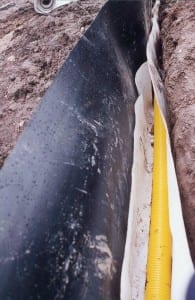With clients often requiring complete life costing and other duty-of-care obligations, it is no longer acceptable to simply plant a tree in an urban setting with the hopes that its roots stay out of trouble. In this final article of the Managing the Root of the Problem series, we discuss current best practice techniques in urban tree root management and explain why one solution doesn’t suit every situation.
While the importance of trees in our urban areas is well known, preventing tree roots from interfering with utilities and infrastructure is an on-going issue.
There are numerous types of specialist root management systems, and each type has its ideal function depending on the particular situation. For example, different urban environments and conditions require different approaches. So rather than a one-size-fits-all solution, it is important to use the right system in order to provide the tree with as much growing advantage as possible.
Approaches to Managing Tree Roots
Root barriers are typically used to direct roots away from utilities and infrastructure and into intended rooting zones. They protect pavements, footings, and curbs from cracking and lifting caused by root heave. Made from either virgin or recycled industrial polymers, root barriers come in various sizes and forms, including rigid modular units and more flexible linear material in rolls. Ribbed designs are most popular, however linear material is also available in dimpled and smooth forms.
Linear Root Barriers – vertical ribbed for root guidance
Ribbed linear root barriers are available incorporating integrally molded vertical ribs designed to direct exploring roots away from nearby utilities, infrastructure, and pavement. Research has demonstrated the effectiveness of vertical ribs in guiding roots downwards and away from paved surfaces. This type of high-density root barrier is available in various depths to suit different situations.
For example, root barrier in 12″ (300mm) deep rolls should be used for applications where tree roots need to be moderately deflected, such as to protect a standard pedestrian curb from surface root heave. Whereas depths of 24″ (600mm) and 40″ (1000mm) can be used for the protection of paved areas, utilities, and shallow service ducts. There has also been a high strength 80″ (2000mm) deep root barrier developed for deeper applications such as housing development, business parks, and new service infrastructure projects.
An important feature to have in a root barrier is flexibility in order to allow the barrier to curve around obstacles, while being rigid enough to hold its form when backfilling. This also helps protect the tree when pavement expansion or repair works are carried out.
These root barriers should be installed vertically in the continuous length of a narrow trench dug on the tree side of the pavement or curb with the top edge flush with the finished ground surface, taking care not to tear or pierce the barrier. The root barrier must be positioned with the ribs running vertically, and the trench should be backfilled and tamped sufficiently to avoid later subsidence. The use of root barriers encourages a tree to develop a deeper rooting system to protect paved surfaces while also providing greater drought tolerance and improved stability.
 Flexible design allows barrier to curve around obstacles but is rigid enough to hold its form when backfilling
Flexible design allows barrier to curve around obstacles but is rigid enough to hold its form when backfilling
Linear Root Barriers – smooth

Modular Root Barriers
If the goal is solely to protect paved surfaces from root heave, it is unnecessarily restrictive on the tree to install a vertical root barrier 5ft deep all around the tree. Preformed modular root directors are a more suitable option for such an application. They incorporate many critical features such as tapered sides, prominent root training ribs, ground locking panels to resist root heave, and have no joints to eliminate risk of root penetration.
These units divert root growth slightly downward and outward to a level where they can safely establish without pavement surface damage, therefore protecting paved surfaces and hardscaped areas.
These units are quick and simple to install, however specifiers and contractors must ensure that an appropriate model relative to the mature size of the tree species is selected.

Modular root barriers direct roots slightly downward and outwards to protect pavement
Properly designed root management systems will not only increase the chances of healthy root establishment, but will also minimize the likelihood of root swirl. Barriers can also be used in conjunction with other tree planting products, such as soil support cells, irrigation systems, and tree grates and guards.
So whether the goal is creating a root free corridor for utilities, protecting building foundations, or preventing root heave from damaging paved surfaces, there is a proven method that will help provide the tree with healthy growing conditions while still protecting the built environment.
The below Root Management Selector Chart is a great resource to pinpoint the best solution for most situations.

Planting trees with appropriate root management systems is a small cost to pay compared to the cost over time of infrastructure damage, not to mention possible litigation, and potential loss of ill-established trees. It’s critical for specifiers and related professionals to be aware of the options and systems available for managing tree roots in the urban environment.



